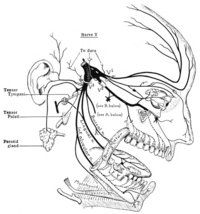
Photo from wikipedia
The mechanisms underlying headaches attributed to hypoxia are poorly known. The activation of spinal trigeminal neurons with meningeal afferent input is thought to be responsible for the generation of headaches.In… Click to show full abstract
The mechanisms underlying headaches attributed to hypoxia are poorly known. The activation of spinal trigeminal neurons with meningeal afferent input is thought to be responsible for the generation of headaches.In the caudal spinal trigeminal nucleus of anaesthetized and ventilated rats, the spontaneous firing of neurons with input from the exposed parietal dura mater and the activity evoked by mechanical stimuli to the dura and the adjacent periosteum were recorded, while the O2 fraction of the ventilation gas was stepwise reduced by omitting O2 and adding nitrogen. The expiratory CO2 level, the arterial pressure, the pulse rate and the peripheral O2 saturation (SpO2) were registered. The meningeal blood flow was recorded using laser Doppler flowmetry, video imaging was used to measure the diameter of dural and medullary arteries.Lowering O2 in the ventilation gas from hyperoxic to normoxic and finally hypoxic conditions was followed by an increase in spontaneous activity up to 300 % of the initial activity in the majority of neurons, while the activity in a minor fraction of neurons ceased. The mechanical threshold was reduced under hypoxia. Arterial pressure, pulse rate and SpO2 fell during stepwise lowering of the O2 concentration, while the arteries of the dura mater and the medulla dilated.Increased neuronal activity in the spinal trigeminal nucleus upon lowering of the inhaled O2 goes along with variations in cardiovascular parameters. The experiments may partly model the conditions of high altitudes and other hypoxic states as risk factors for headache generation.
Journal Title: Pain
Year Published: 2020
Link to full text (if available)
Share on Social Media: Sign Up to like & get
recommendations!